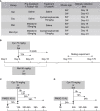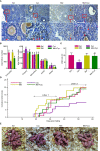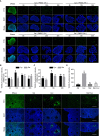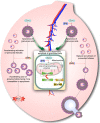Melatonin prevents cyclophosphamide-induced primordial follicle loss by inhibiting ovarian granulosa cell apoptosis and maintaining AMH expression
- PMID: 35992124
- PMCID: PMC9381702
- DOI: 10.3389/fendo.2022.895095
Melatonin prevents cyclophosphamide-induced primordial follicle loss by inhibiting ovarian granulosa cell apoptosis and maintaining AMH expression
Abstract
Cyclophosphaty -45mide (Cyc) chemotherapy in young female cancer patients is associated with an increased risk of premature ovarian insufficiency (POI). This study was designed to investigate the protective role of melatonin (Mel) as an adjuvant against Cyc-induced POI. Female mice received a single intraperitoneal (i.p.) dose of Cyc (75 mg/kg). Mel protection was achieved in mice after i.p. injection of melatonin (50 mg/kg) every 24 h for four consecutive days prior to chemotherapy initiation and for 14 additional days. Ovarian reserve testing, hormonal assays for follicle-stimulating hormone, luteinizing hormone, and anti-Müllerian hormone (AMH), assessment of the oxidative stress status, and measurement of the relative expression of genes in PTEN/AKT/FOXO3a and mitochondrial apoptosis pathways were performed. The results showed that treatment with 50 mg/kg Mel significantly prevented Cyc-induced over-activation of primordial follicles by maintaining the plasma level of AMH and subsequently preventing litter size reduction in mice treated with Cyc chemotherapy. Importantly, Mel treatment significantly prevented ovarian granulosa cell loss by inhibiting the mitochondrial apoptotic pathway. Identifying the protective actions of Mel against Cyc-induced primordial follicle loss has important implications for fertility maintenance in young cancer patients undergoing chemotherapy.
Keywords: anti-Mullerian hormone; apoptosis; cyclophosphamide; granulosa cell; melatonin; primordial follicle.
Copyright © 2022 Feng, Ma, Li, Pei, Deng, Jia and Ma.
Conflict of interest statement
The authors declare that the research was conducted in the absence of any commercial or financial relationships that could be construed as a potential conflict of interest.
Figures






Similar articles
-
Ceramide-1-phosphate has protective properties against cyclophosphamide-induced ovarian damage in a mice model of premature ovarian failure.Hum Reprod. 2018 May 1;33(5):844-859. doi: 10.1093/humrep/dey045. Hum Reprod. 2018. PMID: 29534229
-
AMH prevents primordial ovarian follicle loss and fertility alteration in cyclophosphamide-treated mice.FASEB J. 2019 Jan;33(1):1278-1287. doi: 10.1096/fj.201801089R. Epub 2018 Aug 16. FASEB J. 2019. PMID: 30113879
-
Quercetin prevents primordial follicle loss via suppression of PI3K/Akt/Foxo3a pathway activation in cyclophosphamide-treated mice.Reprod Biol Endocrinol. 2021 Apr 23;19(1):63. doi: 10.1186/s12958-021-00743-y. Reprod Biol Endocrinol. 2021. PMID: 33892727 Free PMC article.
-
Assessment of ovarian reserve by serum anti-Müllerian hormone in patients with systemic lupus erythematosus: a meta-analysis.Ann Palliat Med. 2020 Mar;9(2):207-215. doi: 10.21037/apm.2020.02.11. Epub 2020 Mar 3. Ann Palliat Med. 2020. PMID: 32156138 Review.
-
A putative role for anti-Müllerian hormone (AMH) in optimising ovarian reserve expenditure.J Endocrinol. 2017 Apr;233(1):R1-R13. doi: 10.1530/JOE-16-0522. Epub 2017 Jan 27. J Endocrinol. 2017. PMID: 28130407 Review.
Cited by
-
New insights on mitochondrial heteroplasmy observed in ovarian diseases.J Adv Res. 2024 Nov;65:211-226. doi: 10.1016/j.jare.2023.11.033. Epub 2023 Dec 6. J Adv Res. 2024. PMID: 38061426 Free PMC article. Review.
-
The Role of Lifestyle and Dietary Factors in the Development of Premature Ovarian Insufficiency.Antioxidants (Basel). 2023 Aug 11;12(8):1601. doi: 10.3390/antiox12081601. Antioxidants (Basel). 2023. PMID: 37627595 Free PMC article. Review.
-
The Effect of AMH on Folliculogenesis.Reprod Sci. 2025 May 23. doi: 10.1007/s43032-025-01879-7. Online ahead of print. Reprod Sci. 2025. PMID: 40408029 Review.
-
Review of the Function of the Hypothalamic-Pituitary-Gonadal Axis in Children and Adolescents with Cancer.touchREV Endocrinol. 2022 Nov;18(2):122-132. doi: 10.17925/EE.2022.18.2.122. Epub 2022 Nov 29. touchREV Endocrinol. 2022. PMID: 36694892 Free PMC article. Review.
-
An overview of different methods to establish a murine premature ovarian failure model.Animal Model Exp Med. 2024 Dec;7(6):835-852. doi: 10.1002/ame2.12477. Epub 2024 Sep 1. Animal Model Exp Med. 2024. PMID: 39219374 Free PMC article. Review.
References
Publication types
MeSH terms
Substances
LinkOut - more resources
Full Text Sources
Medical
Research Materials

